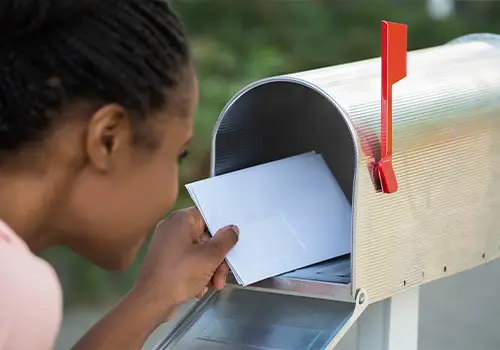How To Address A Formal Letter | [4 Easy Steps Inside]
Table of Contents

With the proliferation of text messaging and emails, many people no longer know how to properly address a formal letter. However, this skill is still a must as letters are still used in many formal communications like job applications, cover letters, and other business mail. There may also be times when you wish to send a letter to a friend or family member through the mail. Thankfully, addressing a letter is not hard. It simply requires knowing the formatting rules and filling in the appropriate information. If you need to send a business letter, then keep reading to learn the 4 easy steps on how to do it.
How To Address A Formal Letter
As we stated previously, addressing a letter is not hard although many people still wonder how to write the address on a letter. Here is what you need to include and where to put it.
— Sender’s Contact Information
This is the first thing that you will include in the letter. It will go on the very first line, and most people recommend using the block format for letters. This means that everything will be left aligned on the page. So, at the top left corner of the page you will put your full name on the first line of the page. If you are sending it from a business, then you should include your business name on the next line. Next comes the sender’s address. This will almost always be your return address. Be sure to include your full street address, although standard abbreviations are fine.
Your city, state, and ZIP code should be included on the next line. Be sure to separate the city and state with a comma. Lastly, be sure to add either a phone number or email address. One of those two items should be included on the last line of the sender’s contact section. This provides an easy way for the recipient to reply if necessary. Once that is included, you are done with the sender’s information section.
— Date Sent
After you add your contact information, you will want to include the date on which the letter was written. This allows the sender to easily see when the letter was written in case there is any question regarding timing. Make sure that you write out the full date including month, day, and year. Do not simply abbreviate using a shorthand number format.
— Recipient’s Contact Information
Now you need to include the recipient’s contact information. The format should be identical to that of the sender’s information. Include the recipient’s name (both first and last) on the first line of this section followed by the company, if applicable, on the second line. The recipient’s address line should come next on which you should place the full street address with street number and street name. On the next line, be sure to include the city, state, and ZIP of the recipient. If you are sending internationally, then the country name will go on this line as well. On the last line of this section you should place the recipient’s phone number or email address. If you do not have this information, then you can leave it off.
One thing to note about the recipient’s contact info is that you might not always know exactly who will be receiving the letter. For instance, suppose you are responding to a job ad at a local company. You should do as much research as possible to try to determine the name of the person responsible for hiring. However, if you cannot find it, that is OK. You should include the company’s name on the first line followed by an attention line next. For instance, ABC Company, ATTN: HR Hiring Manager.
— Insert An Appropriate Salutation
Determine an appropriate salutation for your letter next. Try to be as specific as possible based on the research that you have performed. Use capital letters where appropriate. An appropriate salutation usually begins with dear. For example, Dear Mr. Smith or Dear Mrs. Jones are both appropriate salutations. If you simply cannot find any specific contact information for your letter, then you can use Dear Sir or Madam. The salutation, “To Whom It May Concern” should be used only as a last resort. This salutation is very generic and does not show that you have put much research into the contents of your letter.
— Start Writing
Now you can begin your letter writing! The tough part is out of the way, so now you should just make sure that you use proper grammar throughout your letter. Be sure to close with an appropriate ending, and always sign your name at the end of the letter. For a personal letter, the tone of voice does not need to be extremely formal, but that is very important for professional letters. You can always look online for letter templates to help you get started if you need it.
How To Address The Envelope

Once you have the letter written, you will need to properly address the envelope before dropping the letter at the post office. Here is how you should address an envelope.
— Write Return Address
First, you should write your return address in the upper left hand corner of the envelope. This should include the sender’s name and full address. If the postal service is unable to deliver the letter, they will return it to you at this address.
— Write Recipient’s Address
The name of the recipient and his or her address go in approximately the middle of the envelope. You should write it plainly and clearly. It should be large enough that the postal workers can easily read what is written. Be sure to include any professional titles when you write the recipient’s name such as Dr., Mr., or Mrs. The USPS even has guidelines on how to properly write an address on an envelope.
— Attach Postage Stamp
Finally, attach a postage stamp in the top right corner of the envelope. The USPS will not deliver your letter without the proper postage. If you use a forever stamp, then you never have to worry about postage increasing. If you are unsure, you can always have the post office weigh your letter and tell you how many stamps you need.
Other Letter Types
Now you know how to write a formal letter, but what about other kinds of letters? Read below to learn about several other common letter types.
— Business / Professional Letter
This type of letter should be formatted the same as a formal letter. You will want to include the sender’s contact information, the date, and the recipient’s contact information at the top of the letter. Keep the tone formal and serious and be sure to use perfect grammar when writing this type of letter.
— Informal Letter
With informal letters, many people choose to forego including all the contact information at the top of the letter. It is completely acceptable to simply add the date at the top of the letter, include a salutation, and start writing. The tone of this type of letter can also be much more informal and friendly.
— Cease & Desist Letter
These are formal letters that are often sent by an attorney demanding that one party cease performing a certain action. They should follow the formal letter format, and there may be additional information that your attorney suggests including in these letters. Most people choose to include a subject line immediately before the salutation in this type of letter.
— Demand Letter
This kind of letter will follow much the same format as a formal letter. Similar to a cease and desist letter, most people include a subject line directly before the salutation. There is also certain content that should be included in the body such as your reasons for the demand and the specific demand request itself.
The Bottom Line
Letter writing is a lost art that can be easily revived simply by following the rules laid out in this article. Make sure that you find the correct person’s name and follow the formatting guidelines for your letter. Once you have it written, simply address the envelope, attach a stamp, and drop it in the mail. That is all you have to do to easily write and mail a letter! You are much more likely to get a reply if you send a properly written letter in the first place.
Frequently Asked Questions
Where do you put the date on a letter?
The date should be included between the sender’s contact information and the recipient’s contact information. It should be completely written out with no abbreviations. Including the date allows the sender to know when the letter was written, in case there are timing issues with the delivery of the letter.
How do I address a letter to someone I don’t know?
You should start by attempting to find the person’s name to whom the letter should be addressed. If you are able to find their name, you can look up that person on LinkedIn or Facebook to learn more about them. You can use the information that you gather to make the letter more personal and include specific details that you think would interest that person. If you absolutely cannot find the appropriate contact information, then you will have to leave the salutation more generic.

